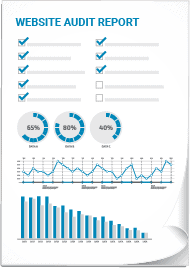The world of article writing is so dynamic that it takes excellent writing skills to come up with good blog title ideas. Every single day, thousands of people are looking for information about products and services on websites, so that they can gauge their interests. You are probably wondering; which tricks do blog posts that attract thousands of likes, shares and tweets use?
Getting target clients to visit your prebuilt WordPress website is one thing, but ensuring that it gets a high ranking is another. Writing an effective title and description is also very important. Your website may possess all the colorful things that attract your visitors’ eyes, but only a creatively-written blog title will capture their attention. So, what are the measures that you can take to ensure your blog gets to reach your target audience? In this article, we take a step-by-step look into how to come up with an effective blog title.
What does a compelling blog post title look like?
If you take a keen look at successful blog titles, you will realize that they have specific things in common. For starters, they capture the interest of your visitors. It does not matter whether they have come across it on Google, email, Facebook, or LinkedIn profiles. What counts is that your target audience falls in love with it at first glance. Here’s a list of attention grabbing blog title templates that work.
Getting them to click on it is another thing that determines the nature of your title. If they like what they see, they will instantly like, retweet, or share with their friends. When more people visit and read the content on your website, you automatically qualify for a good-to-excellent ranking on Google. To get a spot in the first three pages, follow this guide on how to create an effective blog title:
Step 1. Create a Draft
Before you start cooking a specific meal, you need to gather all the ingredients and follow the recipe. Writing also works similarly, only this time, you will be creating a rough draft. Knowing your target audience, what they do, and their demographic information will guide you on how to draft a good blog title ideas.
There is a huge difference between a working title and a topic. For starters, a topic is vaguer than a working title. For example, two topics such as “Preventing COVID-19” or “self-isolation” can generate a working title: “How Social Distancing and Sanitization Helps to Prevent the Spread of Corona Virus.” From this example, you can see how rational the working title is. At this point, you should worry less about being perfect because you are just starting.
How to come up with target keywords
The ultimate goal for a blog title is to get clicks and rankings through the right usage of SEO. Start by having the main keyword and other related keywords that describe your blog post. Take, for instance, you are a wholesale dealer of electronic components in Dartmouth, MA. Your target clients will type the words “electronic components Dartmouth” to access all the suppliers based in that region. So, which type of title will make them want to do business with you?
Research also suggests that people trust titles with numerical signs as opposed to words. In this case, you can consider using, “8 Reasons Why Dartmouth Electronic Components are the Best” instead of “Eight Reasons Why Dartmouth Electronic Components are the Best.” From this example, you will understand the relationship between the correct use of keywords and title tag rankings.
Compare your blog title ideas with your competitors
Once you have gathered the main supporting keywords, visit Google to see yourself in the eyes of your competitors. Find out which keywords they are using as their selling points. For example, a title like “How to Rebrand Your Business” is straightforward, but it does not portray the writer as creative. Still, this should not be a reason to give up.
Step 2. Come up with other title alternatives
Whenever you are writing your draft, you are more likely to come up with only one working title. For a person that wants to qualify as a creative title creator, that is not enough. This is the time to put your creativity to another level. By coming up with more variations, you will have the chance to improve your blogging skills and to come up with catchy blog title ideas.
Whether your target platform for your content marketing strategy is through email newsletters, social media or Google, knowing their terms and conditions is crucial. Some sites will permit up to 100 characters, while others will restrict you to less than 75. Once you have come up with different variations, you will be in the best position to choose the best. In some cases, you may want to test your title using a bracketed clarification.
Step 3. The power of “Power Words”
Whenever you open a door, your curiosity starts to build. You will probably want to know what is inside the house, store, or church. Similarly, a title should be the door for your content. It gives an overview of what you are about to say in your blog. It needs to give way to the content that follows accurately.
The idea you are trying to sell should match with your target buyer’s persona. For example, if your target buyers are teenagers and young adults, you may want to use ‘cool terms.’ But if your audience is of the ages between 40 and 65, you may want to tone down on your words.
One successful blog title tip that has stood the test of time is the use of greed power words. If you are planning to sell Bluetooth earphones to teenagers, you can include words like “Grab your earphones while stocks last.” Alternatively, you can use lust power words such as “Unbeatable offers for enchanting earphones with sexy ear pads.” If you plan on warning your target clients against something, you can come up with a title- “The disastrous effects substandard earphones can cause.” Remember, the use of fear power words in your title is permitted, but it should not occur more frequently.
Step 4. Pass your blog title through analyzer tools
Now that you have added your strong features to your title, it is time you passed your blog title ideas through an analyzer tool. Here, you will be guided on how to create blog-worthy titles that will attract visitors to your WordPress website. It also helps you boost your shares and rankings on Google.
The tool will present your score based on your word balance, word count, unique words, power words, and headline length among others. If you score 70% and above, then you can rest assured that you have qualified as an excellent title creator. However, getting a lower score does not disqualify your competence.
Step 5. Consider optimizing your content
Optimizing your title for search and social purposes is excellent, but it should not be in your top priority. In most cases, persistent optimization may interfere with the soundness of your blog title. Your ultimate goal is to reach a broader range of clients. So if you can optimize it for locations such as blog post titles, SEO title, email subject line or social media posts, go right ahead.
To get started on optimization, you should always remember to set realistic expectations. If your title says “ultimate destination,” then your content should give reasons why it is the ultimate destination.
Step 6. Gauge yourself through someone else
You have written draft, came up with title variations, spiced up your titles, and optimized your SEO. Congratulations! One more thing, finding a third-party to help you brainstorm will also work for your advantage. A tool like WordPress, which comes in both free and premium versions, will assist you in testing your headlines. You can also enter at least two of your titles through email marketing services to see which one stands a chance of getting the best click-through rate. Alternatively, you can use social media platforms such as Twitter or Facebook to test your blog title.
Step 7. Create a catchy and engaging blog title
Naturally, most people have a short span of attention. They can easily skip the content on your blog post just because they find your title as dull. You may have all the products and services a man can buy. But if your post title does not capture their attention, you have lost your selling point. The primary goal for writing an effective title is to give your readers a glimpse of what they will find in your content.
Words can be powerful, but it depends on how you use them. You can consider creating title variations to choose the one with the appealing information. Once you have chosen the right one, pass it through an analyzer tool. You can optimize your title for search or social media, though this step is optional. Once you have done so, you can use tools like WordPress or email to gauge your title. With these six steps, your dominance in the content marketing environment will be felt on all platforms.




